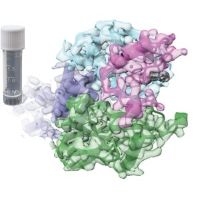Specification
| Description | Recombinant protein from the full-length sequence of Homo sapiens ring finger protein 114 (RNF114) (NM_018683). |
| Organism | Homo sapiens (Human) |
| Expression Host | Human Cells |
| Tag Info | His or DYKDDDDK. Please contact us if you need further information or require specific designed tag. |
| Purity | Greater than 90% by SDS-PAGE gel |
| Uniprot ID | Q9Y508 |
| Entry Name | RN114_HUMAN |
| Gene Names | RNF114 ZNF228 ZNF313 |
| Alternative Gene Names | ZNF228 ZNF313 |
| Alternative Protein Names | E3 ubiquitin-protein ligase RNF114 (EC 2.3.2.27) (RING finger protein 114) (RING-type E3 ubiquitin transferase RNF114) (Zinc finger protein 228) (Zinc finger protein 313) |
| Application | Antigens, Western, ELISA and other in vitro binding or in vivo functional assays, and protein-protein interaction studies; For research & development use only! |
| Buffer | Purified protein formulated in a sterile solution of PBS buffer, pH7.2, without any preservatives |
| Endotoxin | Endotoxin level is < 0.1 ng/µg of protein (<1EU /µg) |
| Length | 228 |
| Molecular Weight(Da) | 25694 |
| Protein Sequence | (The sequence of expressed protein may have some variation from the sequence shown below. Please contact us for the exact sequence.) MAAQQRDCGGAAQLAGPAAEADPLGRFTCPVCLEVYEKPVQVPCGHVFCSACLQECLKPKKPVCGVCRSALAPGVRAVELERQIESTETSCHGCRKNFFLSKIRSHVATCSKYQNYIMEGVKATIKDASLQPRNVPNRYTFPCPYCPEKNFDQEGLVEHCKLFHSTDTKSVVCPICASMPWGDPNYRSANFREHIQRRHRFSYDTFVDYDVDEEDMMNQVLQRSIIDQ |
Background
| Function | FUNCTION: E3 ubiquitin-protein ligase that promotes the ubiquitination of various substrates (PubMed:23645206, PubMed:25165885). In turn, participates in the regulation of many biological processes including cell cycle, apoptosis, osteoclastogenesis as well as innate or adaptive immunity (PubMed:25165885, PubMed:28708287). Acts as negative regulator of NF-kappa-B-dependent transcription by promoting the ubiquitination and stabilization of the NF-kappa-B inhibitor TNFAIP3 (PubMed:25165885). May promote the ubiquitination of TRAF6 as well (PubMed:28708287). Acts also as a negative regulator of T-cell activation (PubMed:25165885). Inhibits cellular dsRNA responses and interferon production by targeting MAVS component for proteasomal degradation (PubMed:25165885). Ubiquitinates the CDK inhibitor CDKN1A leading to its degradationand probably also CDKN1B and CDKN1C (PubMed:23645206). This activity stimulates cell cycle G1-to-S phase transition and suppresses cellular senescence. May play a role in spermatogenesis. {ECO:0000269|PubMed:23645206, ECO:0000269|PubMed:25165885, ECO:0000269|PubMed:28625874, ECO:0000269|PubMed:28708287}. |
| Pathway | Protein modification; protein ubiquitination. |
| Protein Families | |
| Tissue Specificity | Expressed in numerous tissues, including skin, CD4 lymphocytes and dendritic cells. Highest levels in testis. {ECO:0000269|PubMed:18364390}. |
QC Data
| Note | Please contact us for QC Data |
| Product Image (Reference Only) |  |

